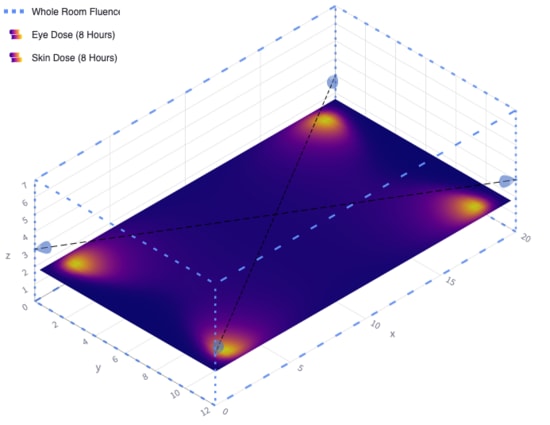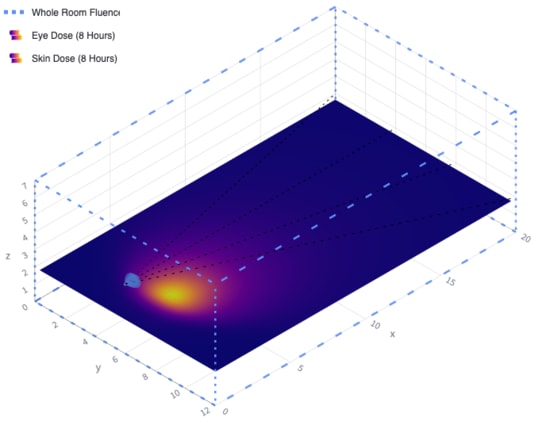I help organize a contra dance in a crowded dance hall, and we've been considering using far UVC to clean the air, reducing infection risk from COVID, flu, and other airborne pathogens. We recently polled the group, and far UVC was very popular, so I think it's likely we'll roll it out. But how should we position the lights?
When I first looked into this, with help from UV researcher Vivian Belenky at the Columbia Center for Radiological Research, they used the OSLUV modeling tool to estimate the efficacy of four lamps on portable 10ft stands, one in each corner. As I started looking into the logistics of setting this up, however, having tall stands on the dance floor seemed difficult to do without some combination of taking up a bunch of floor space and providing a tripping hazard.
Instead of putting them in the corners, a single tall stand in the middle of the stage would be a lot more practical logistically. But would having four lamps so close together be an exposure risk? And how much air cleaning efficacy would we lose?
I prepared two scenarios in the modeling tool, each with four Aerolamps in a 66ft x 40ft x 23ft room. The first case is the one Vivian and I had worked in, with a lamp 10ft up in each corner (config):
The second is what I'd prefer to do, four lamps at the front of the stage, 13ft up (10ft stand + stage height) in the center (config):
On safety, the modeling software evaluates against ANSI/IES RP-27.1-22 using ACGIH (2022) TLVs for 222 nm, and both scenarios are well below limits, even standing in the part of the floor with the highest exposure. [1]
On efficacy, average fluence was 0.289 uW/cm2 (stage) vs 0.306 uW/cm2 (corners), a 5.6% decrease. [2] This is small enough that I think we should go with the logistically easier one, and put them on a single stand on stage.
[1] Specifically, measured over an 8hr period, it estimates maximum
skin and eye doses as:
| Corners | Stage | |
|---|---|---|
| Skin | 16.68 mJ/cm2 | 26.08 mJ/cm2 |
| Eye | 30.41 mJ/cm2 | 39.45 mJ/cm2 |
These are low enough that they'd be safe even for full days: the place where any of these scenarios gets closest to the limit is eye exposure in the stage scenario, and that would require ~30hr of continuous exposure to reach the 8-hour TLV.
Of course if you are moving around the room, as dancers do, your dose is far lower, because you won't be in the single worst place the whole time. The weighted skin and eye doses, again for an 8hr period, are:
| Corners | Stage | |
|---|---|---|
| Skin | 0.12 mJ/cm2 | 0.18 mJ/cm2 |
| Eye | 0.62 mJ/cm2 | 0.81 mJ/cm2 |
[2] The actual effects on pathogens are not linear in average fluence, however, because there are two effects working in opposite directions:
Some pathogens are inactivated with very low levels of UV, and the coverage pattern in the stage case has more areas with no coverage than in the corners case.
Other pathogens are only affected at higher levels, and the maximum fluence in the stage case is higher.
The OSLUV tool gives estimates that translate the full fluence distribution into inactivation to account for these effects. The overall impact, however, was very small (sheet). I saw decreases of the UV equivalent CADR of 5.7% for bacteria, 5.7% for coronaviruses, 5.1% for influenza, and 6.9% for phages.

